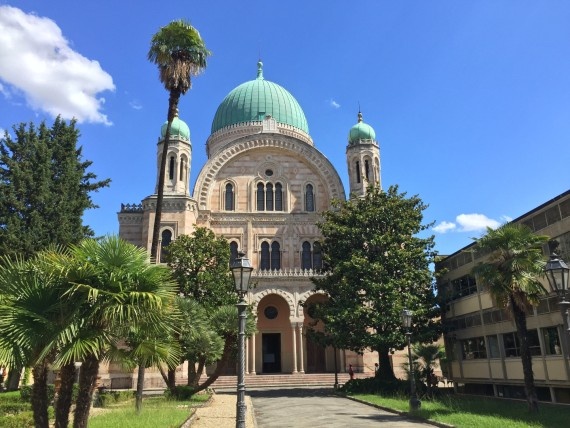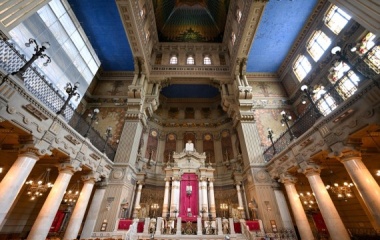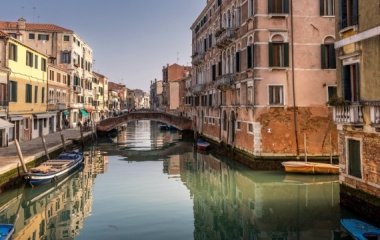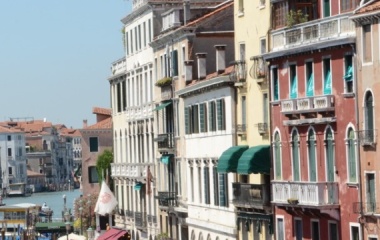
Few people who travel to Italy travel to Pitigliano[1]. It is nestled in the mountains far away from any major city, is accessible only by car after many miles on a curving two-lane highway with little beyond nature in the area. The population today numbers some 3,500 and the Jewish population at its height in the mid 19th century numbered some 425 people, representing approximately 20% of the population. Despite the small numbers there was a complete Jewish infrastructure; a shul, a school, matza factory, winery, mikvah, cemetery, all of which we had the privilege to see.
The Jewish community was well integrated and beloved by the local population; it even was given the moniker Little Jerusalem. It was one of the few places in “Italy” where Jewish life had few, if any, restrictions. When Italy became a united county in 1861 and Jews were given equal rights throughout all of Italy, many Jews left seeking greater economic opportunities – a remote town of 3,000 people does limit one’s choices. By 1931 only about 70 Jews remained. During the war the local community, including the bishop and clergy, at great personal risk, hid each and every Jew and not one person who had remained in Pitigliano was murdered or even deported.The percentage of the righteous amongst the gentiles honoured at Yad Vashem is higher in Pitigliano than anywhere else.
After the war only some 30 Jews remained. Its last official minyan took place on Yom Kippur 1959 and communal Jewish life came to an end. Today, three Jews remain, a 96-year-old women who was saved during the Holocaust, and two of her relatives. In the 1960’s the front of the shul collapsed and for many years the shul was left unattended with no roof and grass and weeds growing on the inside[2]. Yet in a remarkable display of friendship in 1995 the city rebuilt the shul seeking to preserve an integral part of its history.
While many who travel to Italy choose to spend Shabbat in Rome or Venice, we had the good fortune to stay in Florence. From my perspective it is the most beautiful of all the shuls we have seen in Italy (and on our trip to Provence). Ist green dome rises high into the sky and is most noticeable from Piazzale Michelangelo with its beautiful panoramic view of the city. The inside is no less beautiful. The halacha that the shul must be the tallest building in the city is widely observed throughout Europe – with the exception of the Church which no building was allowed to overshadow. The shul was completed in 1882 – after Jews were freed from the ghetto – and “replaced” the two (small) shuls, one Italian, one Sephardic, that functioned in the ghetto.
Sadly, a major flood hit much of Italy in 1966 with water levels rising more than two metres and 90! Sifrei Torah could not be saved; thankfully 30 others were. The Torah we read from on Shabbat morning was over 300 years old – and looked great. Like in so many other areas they don’t make things the same way they used to.
I often comment how interesting, inspiring and religiously significant it is to daven in shuls that follow their own ancient traditions. One realizes that eilu v’eilu[3], that there are many different beautiful ways davening can be done. There is more to shul than nusach Ashkenaz or Sepharad. It is in many ways humbling. Rabbi Gadi Piperno, rabbi of Florence told us, the nusach is “Sephardi Italian tahor”, the pure Italian Sephardic rite”. Like pretty much all Sephardic shuls they say every word out loud. Sensing his crowd – more than half the approximately 100 people in shul Friday night were tourists – the rabbi announced that davening shabbat morning is at 9:00am – but we won’t get to Baruch Sheamar until 9:25 or so! They slowly say all of korbanot and a number of piyuttim, liturgical poems. Davening took just under three hours but from my perspective was not at all shleppy.
Friday night, Kabbalat Shabbat began not with Lechu Neranena, but with Mizmor leDavid. This should not be surprising. Rather what is amazing is how universally observed “Kabbalat Shabbat” is, despite it being a minhag of “only” some 450 years, developed by the Kabbalists in Tzfat[4]. They do sing Lecha dodi but do not repeat the refrain between each stanza. The first line of each stanza is said by the chazzan while the second line is said by the congregation, making Lecha Dodi a responsive reading.
As one would expect, the tunes during davening are all different with two exceptions. Highlighting the unity of Jews around the world, “Acheinu” was sung to the tune we all know. And the traditional tune was used for Adon Olam. When I told the rabbi I wanted to hear an Italian tune he responded there is one but they sing the one known throughout the Ashkenazic world. No community lives in isolation anymore.
Rabbi Gadi Piperno has served as Rabbi in Florence since 2019. He previously worked as an engineer (something the Lubavticher Rebbe also did before transitioning to Rebbe) and what might come as a surprise to many was ordained in the rabbinic school in Rome. I could only smile when he told us he also spent some time in Yeshivat Hakotel, where I learned after high school. Today the official community numbers approximately 700 Jews and there is regular minyan only on Shabbat. Rabbi Piperno highlighted the fact that as Chief Rabbi he is invited to all city functions and is given the same degree of high respect given to the Church leaders in Florence.
Probably the most famous rabbi to serve in Florence was Umbarto Cassuto. Born in Florence in 1883 he became Chief Rabbi in 1922 serving for three years before moving to the world of the academy. Forced from his position of Chair of Hebrew language at the Sapienza University of Rome in 1939, he accepted the position of Chair of Biblical Studies at Hebrew University, a position he held until his death in 1951. Made “famous” by Nechama Leibowitz, he wrote, in addition to a biblical commentary, a critique of Wellhausen and the Documentary Hypothesis. He was one of the few to gain access to the Aleppo Codex – before much of it was destroyed in a pogrom in 1947. The Aleppo Codex is considered to be the most authoritative text of the Tanach – and the one used by the Rambam in codifying the laws of how to write a Sefer Torah.
His son, Dr. Natan Cassuto, succeed him as chief Rabbi. Tragically, when the Nazis occupied Italy in 1943 he was deported to Auschwitz where he was murdered. Of the 243 people – out of a Jewish population of 3,000 – deported to Auschwitz only 13 survived the war. As we noted in our Ponderings from Provence, with the exception of Denmark and Albania, communities that had less than 8,000 Jews combined, Italy had the lowest percentage of Jewish people killed in war.
[1] Some 30,000 people visit a year, a very far cry from the approximately 35 million who visit Rome.
[2] I am reminded of the Mishna in Megillah (3:3) which rules that “a shul that is destroyed one does not cut the grass due to the pain of the soul.”
[3] The expression eilu v’eilu divrei elokim chayim, these and those are the word of the living G-d (Eiruvin 13b), first appears in reference to the debates of Beit Hillel and Beit Shammai. While in practice we follow the rulings of Beit Hillel, the rulings of Beit Shammai are equally valid and a correct interpretation of Torah. In modern parlance it expresses the acceptance of views other than one’s own.
[4] In the Breuer’s community of Washington Heights, Kabbalat Shabbat is said responsively with the chazzan saying the first verse and the congregation the second, the chazzan the third and so forth. They also sit for Mizmor LeDavid. When I asked someone in shul the basis of this minhag, he explained that Rav Shamshon Raphael Hirsch did not want to introduce Kabbalistic practices into his shul but was willing to introduce the recital of a few chapters of Tehillim.



